Make Your Own Birdseed Bells
This is the time of year when I love to make some homemade creations for the birds to enjoy. Most of the time I make my DIY suet cakes which are fun to make in different flavors and that I put in my little suet cake cage out on the tree. This year I got out my recipe for homemade birdseed ornaments again too but then decided to do something a little different with that recipe – – I decided I could turn this mixture into homemade birdseed bells!
Of course the first challenge when you want to make a homemade birdseed bell is how can you get that shape? I decided I could put my recipe mixture into a small flowerpot to get something of the same sort of shape and was pretty satisfied with my final result, although I wish the bottom was just a bit wider like the store-bought type. And although I used a clay flowerpot, you could probably use some other type of disposable container for this method too, such as a plastic yogurt container, or maybe one of those red Solo cups.
How To Make A Mold For A Birdseed Bell
To make a homemade birdseed bell I used a clay flower pot that was labeled as a 4.3″ size. Some quick measuring on my part showed my pot to be 4″ high and 4½” across the top. One handy thing about using a flower pot as your mold is the hole that’s already in the bottom, which will come in handy later in the process when you are inserting your string for hanging your bird bell.
To get everything ready for the birdseed mixture, I first lined my pot with some wax paper. Some folds in the paper are perfectly OK and won’t show up on your finished bird bell. I then took a pencil and poked through the wax paper and out the hole in the bottom of the pot.
Next, I cut a piece of yarn to about 24″ long, folded it in half, and then pushed the folded end through the hole in the bottom so that about a 4″ loop of the yarn was now sticking out. This will end up being the hanger for your bird bell.
Now things are ready to add the birdseed mixture!
The Birdseed Bell Recipe
One of these 4.3″ clay flower pots will hold about 1½ cups of birdseed. So I decided to get busy with the math and calculate how I could make a smaller version of my birdseed ornament recipe (that uses 4 cups of seed) to make a small 1½ cup size batch instead. Here’s what I did:
I mixed together 1 cup birdseed, a ½ cup black oil sunflower seeds, and a ¼ cup of cornmeal.
Then I made my gelatin mixture by dissolving 1 teaspoon of unflavored gelatin in ¼ cup of hot water. Once those were mixed I added in 1 tablespoon of light corn syrup. Then this gelatin mixture gets thoroughly mixed into the birdseed mixture. (complete printable recipe is below)
Putting It All Together
Once the seed mixture is all stirred together you can put it into your prepared birdseed bell mold. I spooned in the mixture while I held the piece of yarn in the middle up straight (spooning the mixture around it), and patting things down a bit once it was all filled. You should still have a few inches of yarn sticking out after it’s all filled.
Then put everything in the freezer for about an hour. Once it’s hardened up, you can remove it from the mold by pulling on the wax paper to lift it out and then carefully removing the wax paper from around the bell.
NOW . . . here’s the final important detail about your string hanger. If you pull on it too quickly, it will just pull through and come right out of the bird bell. I found that you have to let your bird bell sit for almost a week if you want it to be really set hard enough so that the string won’t pull out.
My solution for getting my bird bell ready to go more quickly was to put a washer on the bottom of my bells to keep it from pulling through. (I used the 3/16″ x 1¼ size of washer). I thought this might also be a little sturdier too for the squirrels who always (ALWAYS!) get into whatever I put out for the birds. I attached the washer by just threading the yarn ends that were sticking out under my bird bell through the hole of the washer a couple times and tying a knot.
Another method that I have not tried but that might also work, would be to wind the yarn through the mixture a little more when filling the mold so that it is not on such a straight path for it to come pulling out.
And then your homemade bird bells are complete! You can hang them on the trees for the birds to enjoy.
Or for squirrels to enjoy . . . as I was taking pictures for this post, this little guy sat right above me in the tree, chattering impatiently, just waiting for me to leave so he could get back into the birdseed. Oh well. I guess squirrels have to eat too.
Here’s the complete printable recipe:
Homemade Birdseed Bells
Materials:
- 1 cup Birdseed
- 1/2 cup Black Oil Sunflower Seeds
- 1/4 cup Cornmeal (or Flour)
- 1 teaspoon Unflavored Gelatin (about half a packet)
- 1 tablespoon Light Corn Syrup
Additional Tools:
- 4.3" Clay Flowerpot
- 24" length of yarn or string
- Wax Paper
Instructions:
- Prepare the clay flowerpot by lining it with wax paper, and then poking through the wax paper at the bottom with a pencil, and out the hole in the bottom of the pot.
- Fold the 24" length of yarn or string in half and push the folded end through the hole in the bottom of the pot, pulling it through until about a 4" loop is sticking out of the bottom of the pot. You can then begin to make the birdseed mixture.
- Mix the birdseed, sunflower seed, and the cornmeal (or flour) in a mixing bowl and set aside.
- Measure your 1/4 cup of water in a glass measuring cup. Heat the water just a bit in the microwave (about 30 seconds - you want it hot enough to dissolve the gelatin).
- Mix the teaspoon of unflavored gelatin into the hot water and stir to dissolve.
- Next, add the tablespoon of light corn syrup to the gelatin mixture.
- Pour the gelatin mixture into the birdseed mixture and stir until everything is well mixed.
- Spoon the birdseed mixture into the prepared mold, holding the string up straight as you spoon the mixture around it. Pat the mixture down a bit once it is all in the flowerpot mold. You should have a few inches of string still sticking out when you are done filling the mold.
- Put the filled mold in the freezer for about an hour to harden up. Then remove from freezer and pull up on the wax paper to remove the bell from the mold. Carefully pull any remaining wax paper away from the bird bell and discard.
- You may then want to let your birdbell set for about a week to thoroughly harden and dry. This will keep the string hanger from pulling out. If you would like to hang your birdbell before then, you can tie a washer onto the string ends hanging out under the birdbell to make the bottom more sturdy. Trim any remaining yarn pieces under the bell as needed.
Notes:



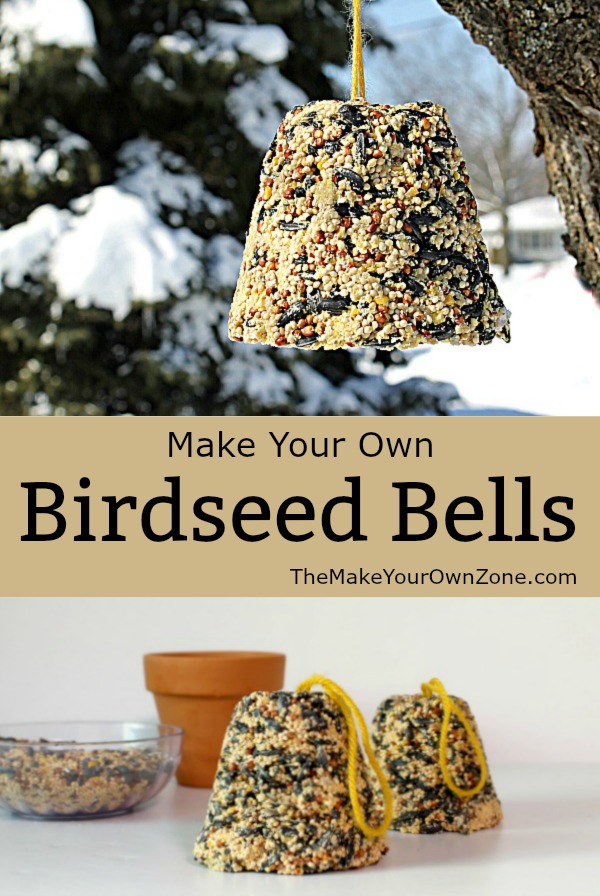
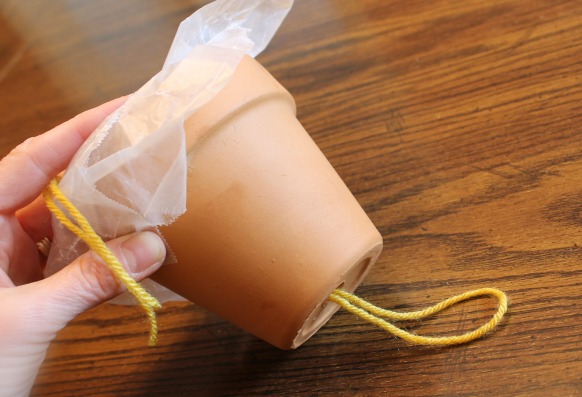
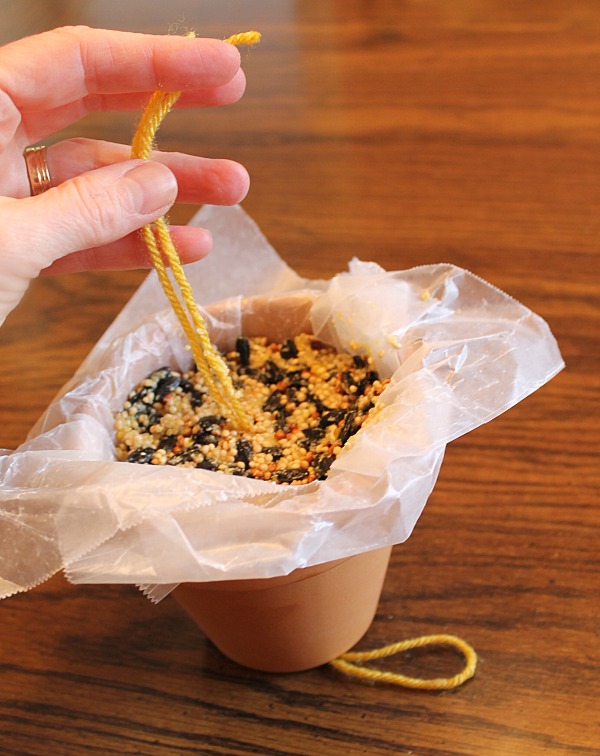
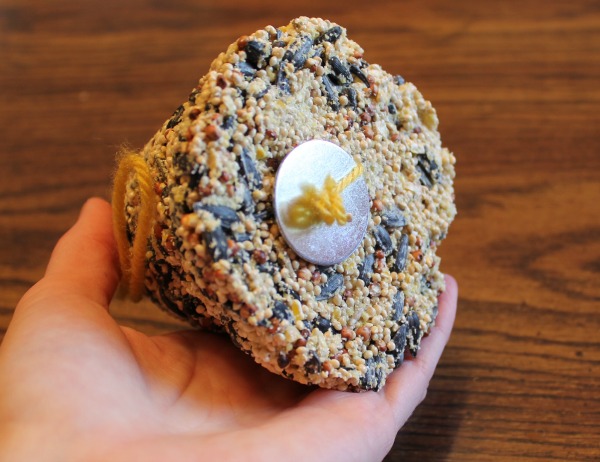
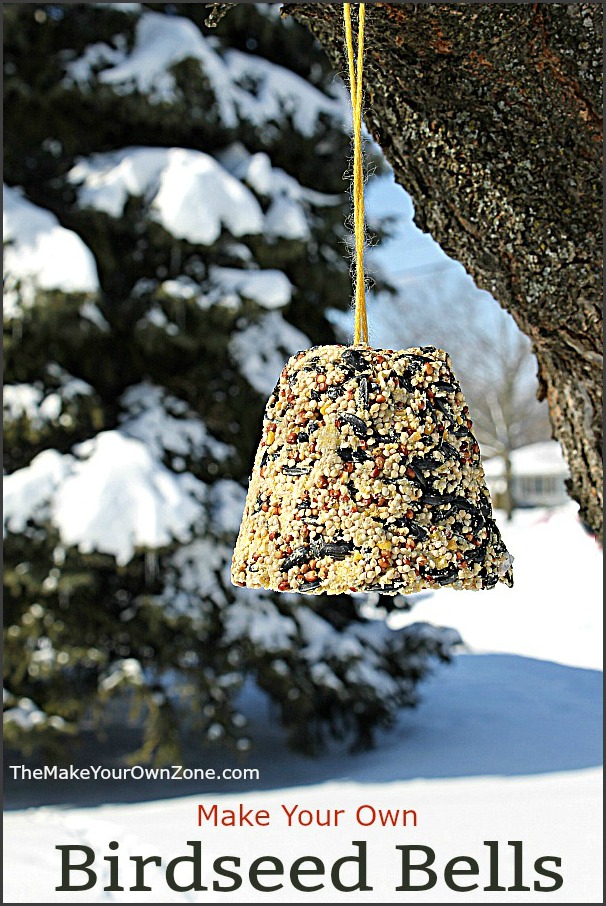
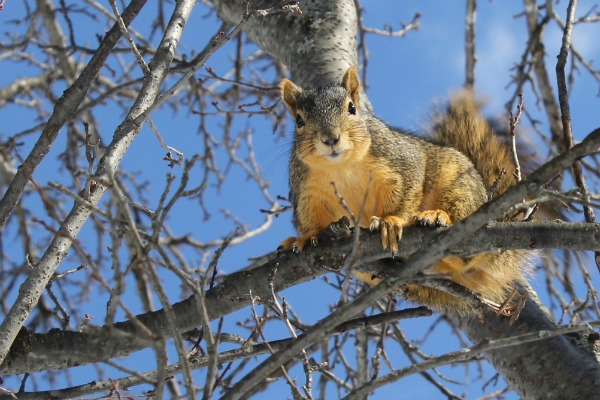
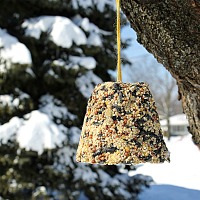
How long is this recipe? Good for once you hang it. Do any of the items go bad? Thank you.
I have never had any of the ingredients go bad, but it’s always been cold winter weather when I hang these bird bells out too.
Thanks for sharing! Does it keep long?
In cold weather outdoors, this will keep well (as long as the squirrels don’t get at it right away!). I’m not sure how long this would last in rainy weather (as I’ve always hung mine out in snowy weather).
This looks so fun! What a great gift to make for grandparents!
Hi, thanks for this! Question: Will the homemade bird bell melt due to the gelatin? Thanks a again!!
Sometimes the gelatin cakes can dissolve a little more quickly in the rain. You could try substituting a 1/2 cup of melted lard to hold the seed together instead.
Oh how beautiful! Thank you so much for sharing this with us. I’ve been spending fortunes at the supermarkets buying 1.2 kg boxes of sunflower seeds (for birds) which cost $7.00 each, and bells are $6.60. My litt
sulphur-crested friends go through at least 3kg of seed every day. They are huge birds and fly pretty long distances back n forth to their nests daily, and require the sustanance to do that. Hopefully now I can save some money and my darlings will be having fresh home made treats! Yummy!😋🥰
Will this method hardened the bell? Cause I don’t the birds to finish it in a few hours.
Yes, the bell will get hard but if you are concerned about the gelatin mixture staying hard enough outdoors in the elements, you could try substituting about 1/3 cup of melted lard for the gelatin.
Can these be made ahead of time and stored?
Yes, but I would keep them in a cool, dry place.
Thank you for sharing your birdseed feeding recipes!
Corn syrup is even worse for animals than people! Check Audobon.com. Also cornmeal is not great and gelatin is questionable. But all those unnecessary. Keep it simple All you need is coconut fat & a light splash of vegetable-based cooking oil for your liquid. Melt in saucepan or microwave, being careful to only melt it, not boil. Stir in bird seed and anything else, like peanuts or dried fruit (NO SUGAR ADDED) until you get a consistency between cake batter and cookie dough. Then use molds or pat into cookie cutters, etc. All natural!
These instructions for constructing the bell are awesome! But the ingredients really are not good for our feathered friends.
I don’t know if it was mentioned here, but always have a clean water source if you’re going to be feeding birds. I have a drip system. I simply attached it in such a way as to fill the water dish. I also keep the dish at a slight angle. When my drip system comes on, more than enough water fills the dish, with the angle letting the overflow keep the dish a lot cleaner.
Useful x two! Plant or put potted flowers that attract hummingbirds and butterflies under the side(s) that the water overflow drips off. If you fill it by hand, overfill the dish – which should be filled with fresh water daily, and water your flowers at the same time! You’ll have a beautiful mini-bird and butterfly sanctuary. Don’t worry about the water & bugs, the birds will eat them!
For those who want to take it a step up with the DIY, get a glazed ceramic plant pot saucer. At least 10″ diameter, about 1″ deep. Use a masonry bit to drill a hole in the middle just big enough to get your 1/4″ drip line through. Watch YouTube if you’ve never drilled ceramics. Push the tube through, attach an adjustable sprinkler drip head, then pull the slack out until the head is about an 1″ high. Uses clear silicone or cement patch to seal around the tube – on both sides of the dish – let cure for 24 hours & ta-da! I put my saucer in a metal plant stand, attaching the hose up a leg to the underside of the saucer. An extra way to add visual appeal and secure the line!
Adding cayenne pepper has kept the squirrels away from my bells! They do not like spicy but the birds love it and it doesn’t harm them! Thanks for all of your DIY’S😉
I did that also and it works great!
This recipe dissolves in the rain and snow.
Loved this post, thank you. I recently put up a store bought seed bell and was amazed at the feast the chickadees had. There was always one Or two birds on the bell with several awaiting their turns. Within three hours of hanging , the squirrels snatched it away. Inventive little creatures! I plan on trying my hand at your recipe for the little birds and ,of course , the squirrels
what does the corn syrup do? is it necessary?
i’ve made this & the birds do not like it
Corn syrup or sugar in u’r mix is bad for birds. Please don’t use it!
Add some dried fruits instead like raisins or cranberries.
Can you add peanut butter
Yes, I think you could adapt this recipe and add some peanut butter to the mixture.
My son and I tried these. They came out of the freezer great and when I walked back an hour later they were in a pile of birdseed 🙁 realized later i used pectin instead of gelatin by accident. Would that have caused my problem? My sister used gelatin and had my same problem. Any suggestions for us? Thanks! We appreciate it ♡
One thing you could try is to use melted lard instead of the gelatin. I think about 1/3 cup of melted lard could be substituted into this recipe for the gelatin. Perhaps that will hold up a little better for you. I can usually find lard in my local grocery store with the Hispanic foods and it is sometimes also labeled as “Manteca”.
The only other thought I have is that maybe try letting them harden in the freezer for a longer period of time, and then also let them cure at room temperature of a few days.
I was also wondering about the use of corn syrup. I made bird feeders years ago with warmed peanut butter as part of the binding agent. they were only good in cold weather though.
any idea of what commercially-made bird bells use?
Probably too warm outside, and you should us something with fat like suet as a base, not gelatin that will dissolve in the rain or snow…..homemade should not be put out side if the temp is above 70 degrees as they will get moldy or rancid….bad for the birds
Where is the best place to hang it? In a tree or from a Shepard’s hook? Does it matter?
I always think it’s better to hang it from a tree branch if that’s available to you. When it’s in a tree, the birds can easily go from feeding on the bell to other places of safety in the tree if they want. However if you don’t have a tree, a shepherd’s hook will work too. My shepherd’s hook with a feeder on it is near some bushes and the birds love to flit back and forth from the hook to the bushes.
Is the corn syrup and gelatin safe for the birds?
My understanding is that yes, they are OK for birds.
No they are not Beverly. Not at all. Do some dam research.
The commercial bird bells by KayTee have both gelatin and dextrose (sweetener derived from corn) listed in their ingredients. So do you believe this trusted company is selling things that are harmful to birds? What is your research? Oh, and you spelled *dam* wrong, unless you would like me to research dams that are holding back water.
An unnecessary nasty comment! Excellent response from Beverly 🤓
Anything salty is not good for the birds…like bacon. It dehydrates them.
Just put my efforts outside – like using the gelatin; also made a larger recipe and put in a milk carton – worked great for the bigger suet holder
I’m sure the birds will appreciate your efforts Barb!
Can someone answer why mine molded? Thank you
How warm was it outside? Above 70 degrees will mold. I’m not a fan of gelatin as a base…you should use rendered fat( suet) as a base,and only below 70 degrees. Also, the gelatin will dissolve in the rain..
This is very useful and I am going to try it. Someone might wonder — as I did before I bought a seed bell — why one would use a seed bell when it is so much easier and way cheaper to just put the seeds in a feeder. The answer turns out to be that some birds cannot manage loose seed but can handle a seed bell. The Downy Woodpeckers, for example, can’t hold black oil sunflower seeds under their feet and peck at them the way the chickadees and nuthatches do, but they can peck at the sunflower seeds and eat them when they are immobilized on the bell.
Interesting info Gayle – thanks for sharing!
Question … will this “melt” in the hot weather?
I have only used my birdseed bells during the winter months so I can’t speak from personal experience, but yes, I do think if the weather was very warm, these homemade bells might begin to melt.
You should use fat not gelatin and do not put out if its above 70 degrees
I had a problem with mold after the 4 day hardening period, anybody else?
I have not had any mold, but I always make these in the winter and I keep my house somewhat cool (68 degrees). Do you perhaps live in a warmer or more humid climate? Perhaps drying them in the refrigerator could help.
I add cornmeal,flour,crisco, peanut butterand chopped nuts to bird seed. Also this can be packed into small limb (around 3-4 in across top ) that hub has drilled a few holes in. Birds love it and can hang on side to eat
I love the idea of putting the mixture in a small tree limb Tanne! Thanks for sharing 🙂
I put everything I can find in our pantry in my seed cakes as well as a variety of bird seeds. General bird seed, black oilers, sunflower seeds, thistle, cracked corn, chopped peanuts, bacon grease, chunky peanut butter, raisins, chopped prunes, dried apple, oatmeal, cornmeal, Cheerios and wild rice.
Don’t feed rice to birds, please!
Wild rice really isn’t rice, it’s grass seed! I see birds eating it all the time when I’m fishing!
Of course wild rice is rice 😂We eat it all the time . Check out the price per pound, you don’t pay that for grass seed. 🤭